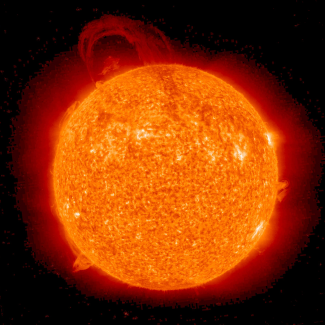Senior research associate Brad Hindman of the Toomre group uses helioseismology to understand what’s happening under the surface of the Sun. Helioseismology is a lot like the ultrasound tests used to evaluate medical conditions. However, there’s a big difference: physicians already have a good idea of the basic structures they are probing with sound waves. Helioseismologists don’t. They study sound that travels below the Sun’s surface to learn about the structure and behavior of the Sun’s convection zone, which comprises the outer third of the Sun. However, if they misinterpret the nature of the sounds they analyze, then they are likely to miss the mark in determining what’s happening inside the Sun.
Thus far, solar physicists have identified two longterm wind patterns, or circulations, that exist within the convection zone. The first of these is a wind pattern directed along latitude lines (east-west) that varies in strength from equator to pole. This pattern results in an equator that rotates around the Sun in 25 days, while the poles rotate in 28 days. The second wind pattern follows longitude lines (north-south). Both of these circulations are crucial ingredients in the Sun’s magnetic cycles.
The first wind pattern has been mapped out successfully by helioseismologists. The pattern of fast equator and slow poles persists throughout the convection zone. The second wind pattern has only been mapped inside the extreme upper portion of the convection zone where the winds flow away from the equator and toward the poles. However, solar physicists believe that there is also “return flow” toward the equator in the deeper layers of the Sun. Over the past few years, helioseismologists have looked for this return flow with sound waves. But, as it turns out, detecting and measuring these deep flows is challenging.
Hindman has recently demonstrated that many scientists have been barking up the wrong tree. They’ve been trying to measure a Doppler shift in the sound waves from the deep flows. However, they were assuming that the Doppler effect would manifest as a shift in the frequency of the sound waves. Many people would make the same mistake. After all, the Doppler effect is often illustrated by the change in pitch that is experienced as a train passes by. This change in pitch is usually described as a change in the sound wave’s frequency. In the case of the Sun’s wind patterns, however, the Doppler effect causes a change in the phase and wavelength of the wave instead of the frequency, which is largely unaffected.
So, Hindman says that instead of trying to measure frequency or wavelength shifts in these sound waves, scientists should be focusing on measuring the sound waves’ spatial phase. A deep return flow will cause this phase to change as a function of latitude. This variation will be larger when the deep flow is faster. And, as with medical ultrasound tests, phase measurements should make it possible to deduce structures in the winds as they interact with the sound waves.
The next step is clear. Hindman plans to analyze measurements from the Helioseismic and Magnetic Imager aboard the Solar Dynamics Observatory, launched in February of 2010. “We know we’re absolutely right that people have done these measurements incorrectly in the past,” he says. “All we need now is about eight years of new data to better understand the Sun’s deep flows.” (While waiting for the year 2018, Hindman and his collaborators will be testing their ideas on data sets from older instruments.)
Such an understanding will be critical for predicting space weather events such as the huge ejection of mass from the Sun in the picture above. Hindman wants to be able understand the solar dynamo well enough to predict the ejection of such giant clouds of charged particles, which not only wreak havoc on satellites and electricity distribution networks, but also could prove fatal to astronauts accidentally caught up in them. Mapping out the Sun’s internal winds is an important step toward developing an early warning system for solar eruptions. - Julie Phillips




